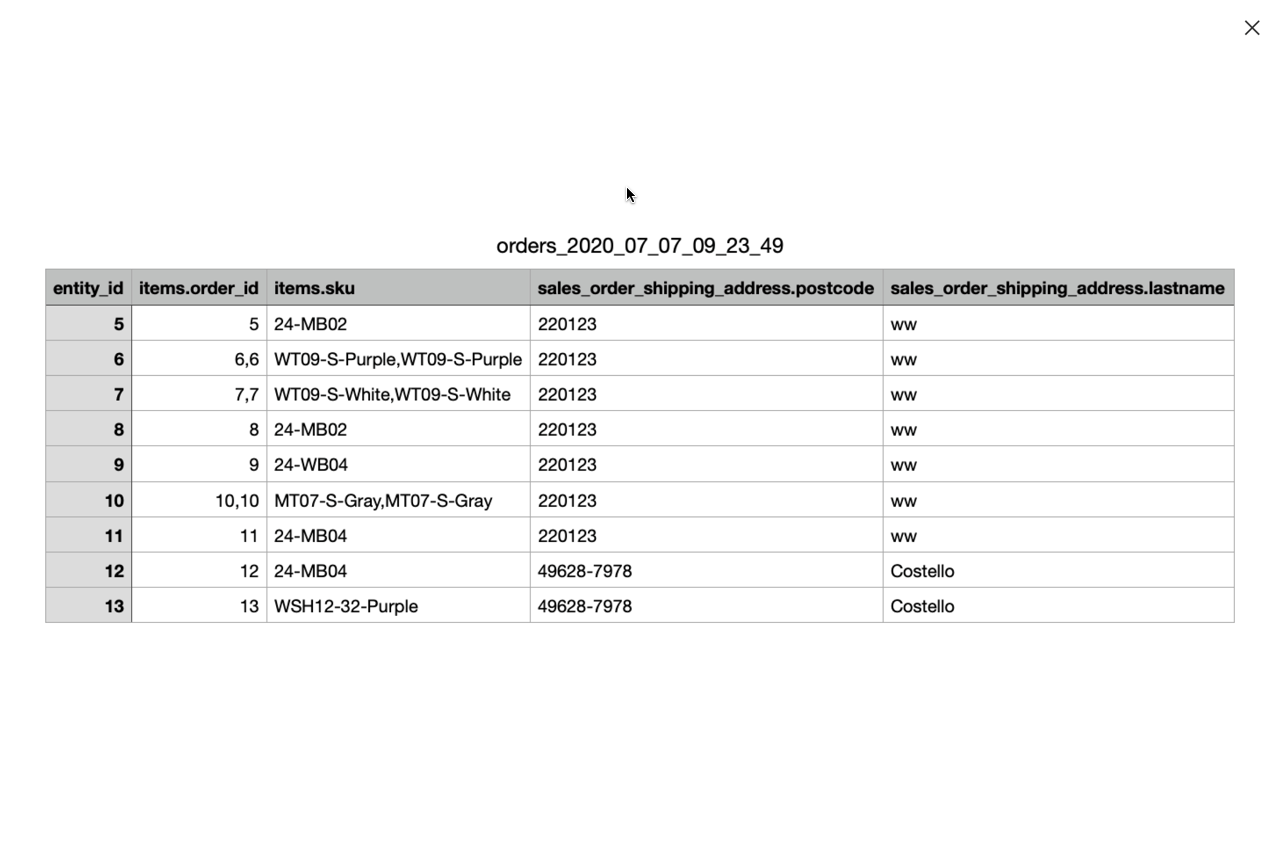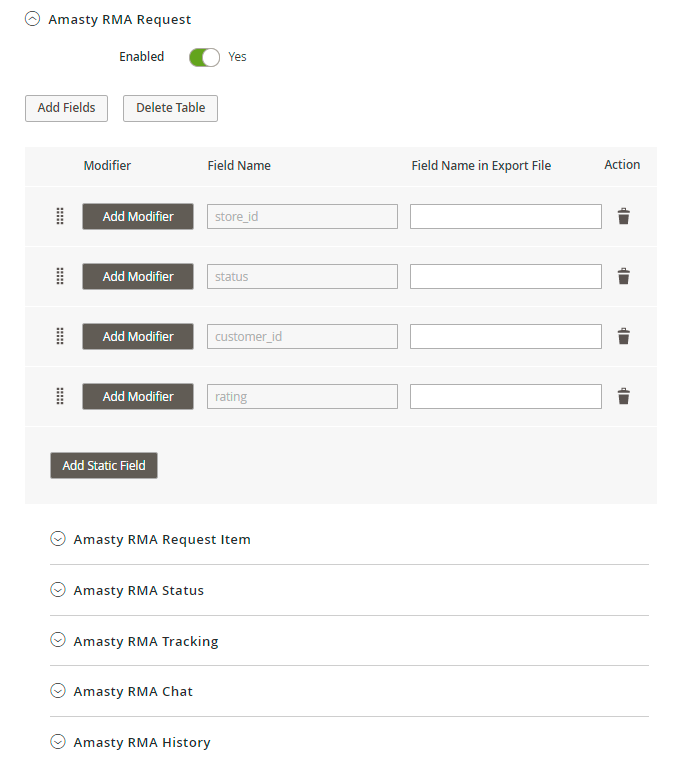User Tools
Site Tools
Sidebar
magento_2:export_orders
Table of Contents
For more details see how the Export Orders for Magento 2 extension works.
Guide for Export Orders for Magento 2
Connect your Magento instance to other systems and efficiently export orders to them. Add to export file any order data, fields from 3rd-party extensions, create order export profiles and migrate orders regularly.
- Build export profiles in 6 various formats
- Easily find any order entity and add it to the export file
- Change the names of columns in a file to meet the recipient requirements
- Execute profiles by schedule, event or manually
- Use filtering to add only relevant order data to the export file
- Check extended options with the 2 extra Amasty Export modules
The new Amasty_OrderExport extension is not compatible with the previous Amasty_Orderexport. If you have the old vesrion of the extension, please, follow the steps below to avoid conflicts:
- Disable Amasty_Orderexport with the command:
bin/magento module:disable Amasty_Orderexport
- Run the command:
bin/magento setup:upgrade
.
The Export Structure
Amasty Export by now has 3 separate modules to carry out export tasks:
- Export Orders: a separate export to deal with order entities
- Amasty Export: suitable for one-time export of any available entity
- Amasty Export PRO: a tab to create cron jobs concerning export activity
The more Amasty modules you have, the more entities you will be able to export in the simplified module and in the PRO version. Follow Import & Export solution updates to discover new possibilities.
Keep in mind, that if your export managers have specific permissions to the admin panel, you need to grand them access to both Export Orders Profiles and Amasty Export. Otherwise, they won't be able to execute the export.
Export Orders Configuration
Before building export profiles, configure the basic order export options.
Read this article to see top 6 most common use cases and how to set them up.
Go to Stores → Configuration → Amasty Extensions → Export Orders.
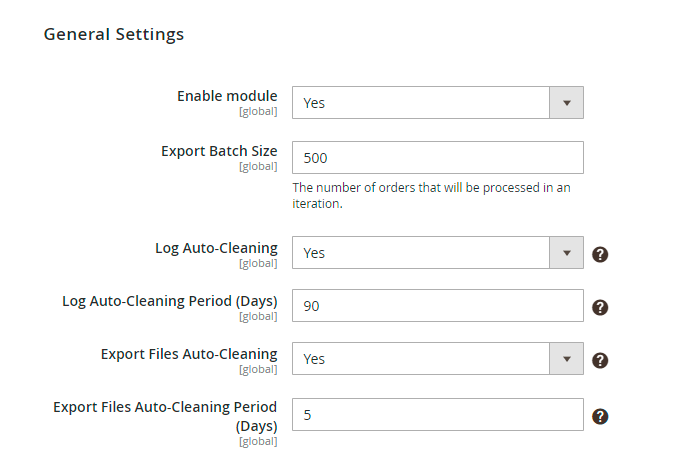
Enable module - select Yes to activate the extension.
Export Batch Size - set the number of orders that will be processed in an iteration.
Log Auto-Cleaning - choose Yes to clean logs automatically. The records will be removed from Export History after the period specified below.
Log Auto-Cleaning Period (Days) - define the period after which export history will be cleaned.
Export Files Auto-Cleaning - if enabled, the generated export files will be automatically removed from the server after the period specified below.
Export Files Auto-Cleaning Period (Days) - identify the period after which the files will be removed from the server.

Enable Multi-Process Export - set to Yes to speed up the export of orders. Remember, that this option is added specifically for orders. The multi-process for Amasty Export and Amasty Export Pro should be enabled in the other tab.
The 'Multi-Process Export' feature requires the PHP extension 'pcntl' to be installed on the server. If you enable the feature and no performance boost happens, please ask your hoster/system administrator to check if the 'pcntl' extension is installed.
Number of Parallel Processes - specify the number of processes according to your server capabilities. The more parallel processes are set, the faster the export process goes, but the higher the server loads.
Export Order Profiles
The extended order export functionality allows you to create flexible profiles for export and execute it on regular basis. To view all the profiles, proceed to System → Export Orders → Profiles.
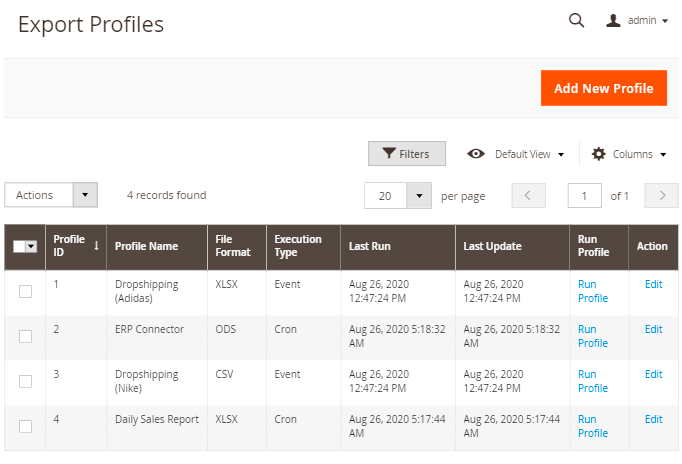
You can view, delete, add new profiles or run any of them manually right from the grid.
To create a new one, hit the Add New Profile button and follow a profile set up steps.
General Configuration
In the first tab adjust the general information of the profile.
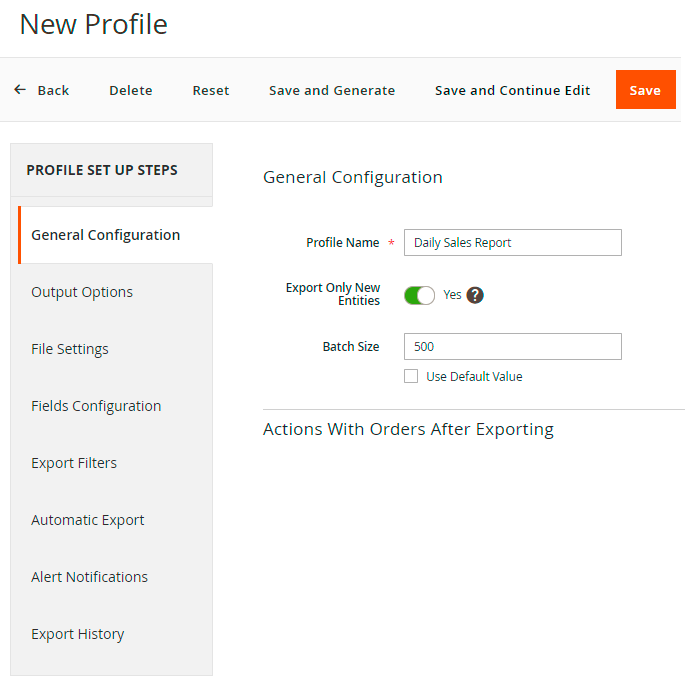
Profile Name - specify the name of the profile for internal usage. This name will be displayed in the grid.
Export Only New Entities - the previously exported orders will be skipped if the setting is enabled. The option is useful in case you export the profile regularly and only newly created orders are needed.
Batch Size - set the number of orders that will be processed in an iteration. You may configure batch size for each profile separately or specify the value in general configuration and use this default value.
You can duplicate the already created profiles if you want to build a profile similar to the existing one.

Actions With Orders After Exporting
You can also automatically execute particular actions when the orders are exported.
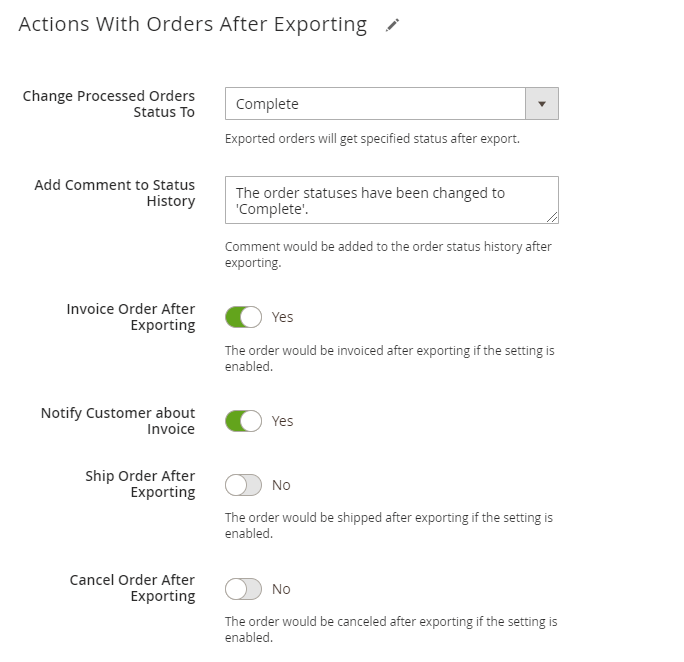
Change Processed Orders Status To - specify the status that exported orders will get.
Add Comment to Status History - comment would be added to the order status history after exporting.
Invoice, Ship or Cancel orders after the export if needed. When any of these actions are enabled, you can additionally notify customers.
Output Options
Proceed to the configuration of output options.
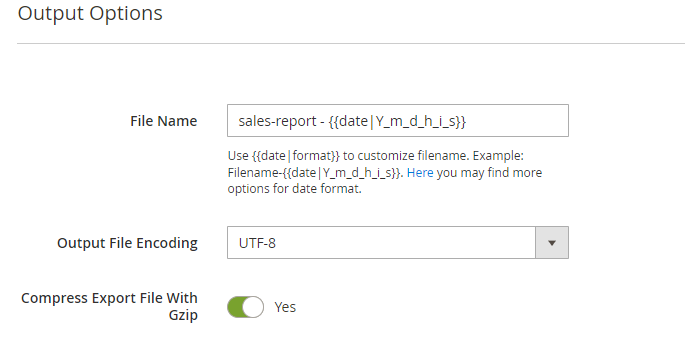
File Name - specify the title for the export file.
Use {date|format} to customize filename. Example: Filename-{date|Y_m_d_h_i_s}. Here you may find more options for date format.
Output File Encoding - choose the suitable type of export file encoding from the dropdown. UTF-8 is used by default.
Compress Export File With Gzip - enable the toggle to compress the file and save extra space on a server.
Export File Storage
Specify where to export the profile: on internal or external server, send the exported file by email or using API.
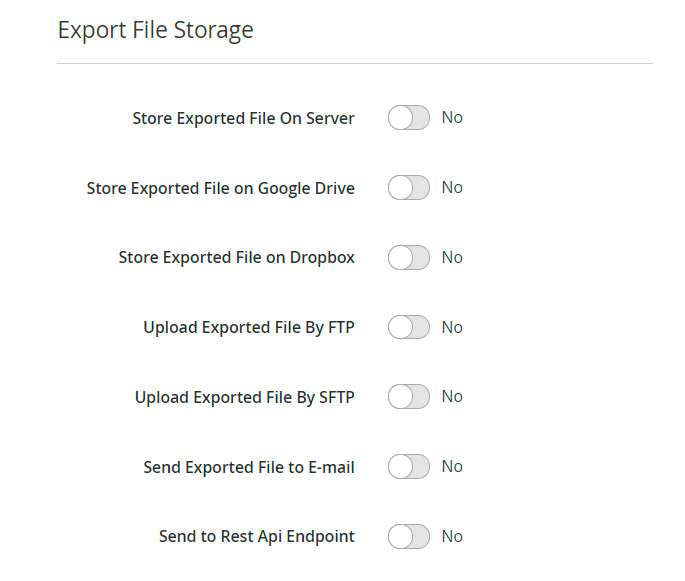
If Store Exported File On Server is enabled, provide File Path and File Name on Server. The file will be saved in Magento 'var' directory relative to the specified path.
If you want to Upload Exported File By FTP / SFTP, you will need to fill the following fields:
- Host
- User
- Password
- File Path
- File Name for FTP/SFTP.
For FTP you can also enable a Passive Mode.
In case you want to Send Exported File to E-mail, provide:
- Email Sender
- E-mail Recipients
- E-mail Message Subject
- Email Template.
If you are using Send to Rest Api Endpoint, provide:
- Rest Api Endpoint
- Auth (No Auth / Bearer / Basic)
- Method (POST / PUT)
- Content Type (JSON / XML).
Dropbox Configuration
To export to Dropbox, you will need to provide the access token. Follow the steps below to get the token.
1. Go to https://www.dropbox.com/developers and sign in.
2. Hit the Create Apps button.

3. Choose an API, a type of access you need and specify the title for your folder.

Agree with the terms & conditions and click Create App. You will be automatically redirected to the folder configuration.
4. Proceed to the Permissions tab.

Grant the permissions to write the files and click Submit.
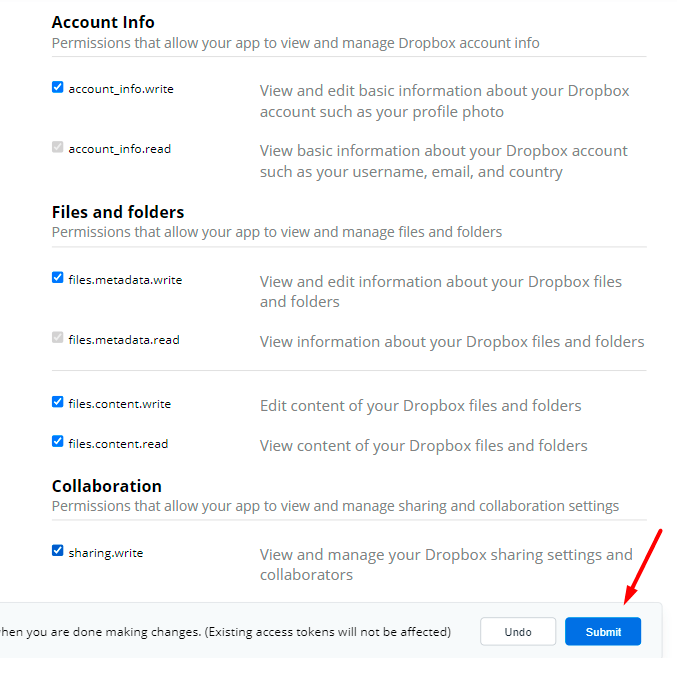
5. Return to the Settings tab.
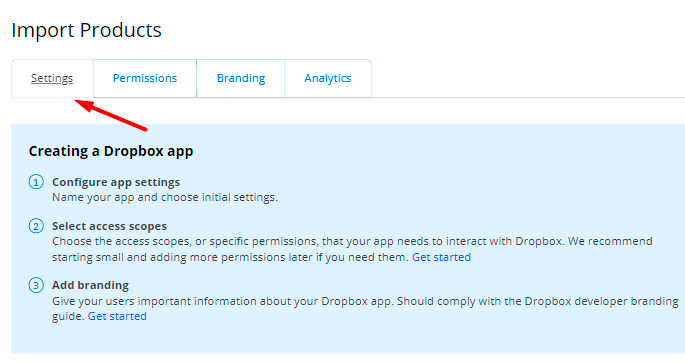
6. Find the OAuth 2 section and hit the Generate button below the Generated access token field.
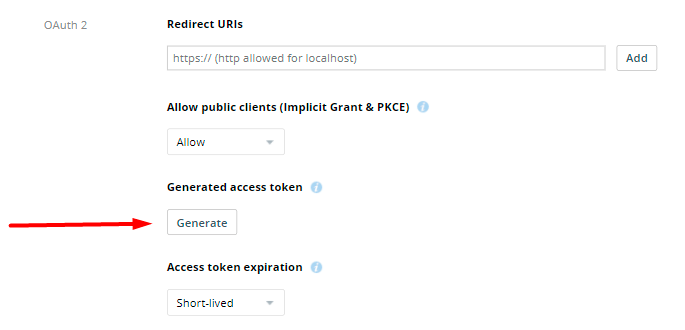
7. Copy the token and paste it into the Generated Access Token field.
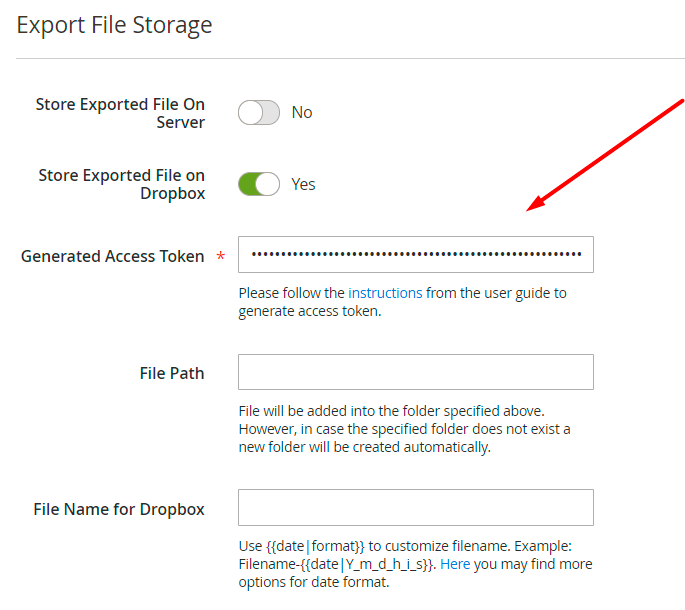
Google Drive Configuration
To set the integration with Google Drive, you need a specific API key. To get the key and configure this output option correctly, follow the steps below.
1. First of all, you need to install Google APIs Client Library on your Magento instance. Click here and install composer require google/apiclient:“^2.0”.
2. Go here and choose a project or create a new one if necessary.
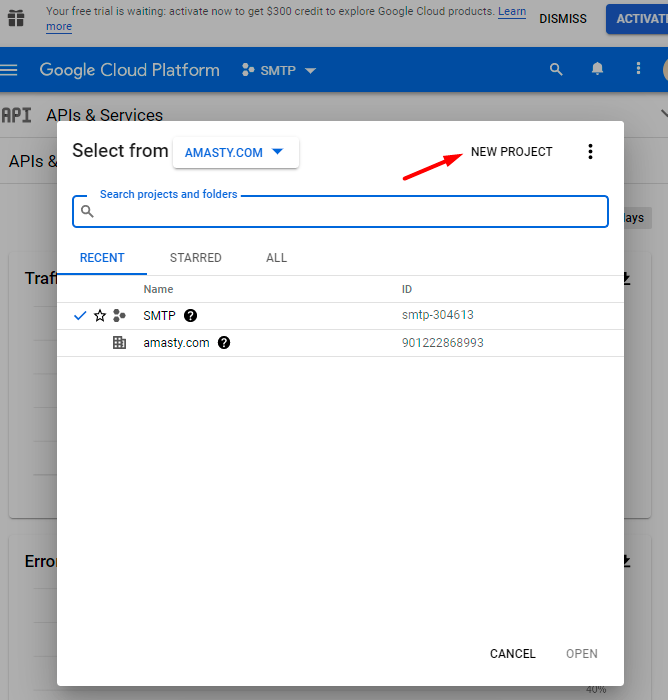
3. When the required project is chosen, return to this page and enable Google Drive API.

4. If everything is correct, you will see the following status:

5. Click Manage and proceed to APIs & Services → Credentials. There click Create Credentials →Service account.

6. Provide Service account details. You can skip Step 2 and Step 3.
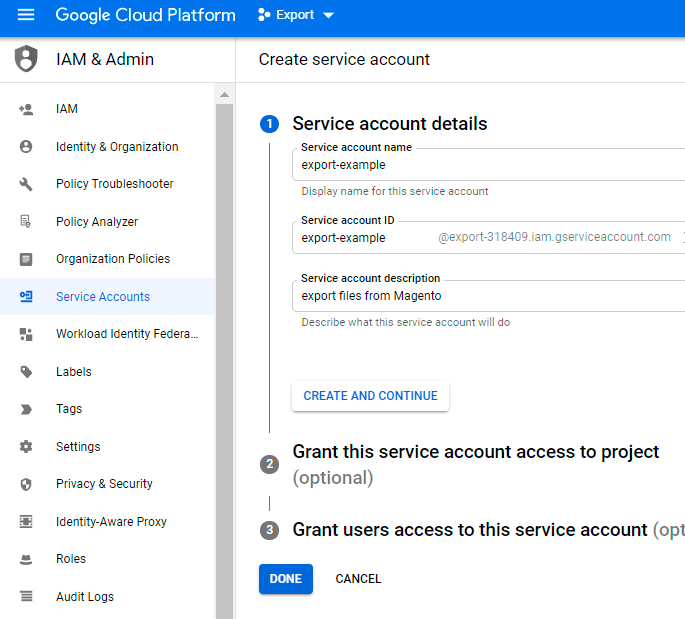
Click Done.
7. Navigate to the Service accounts tab and find the required service. Expand the Actions dropdown and hit the Manage keys option.
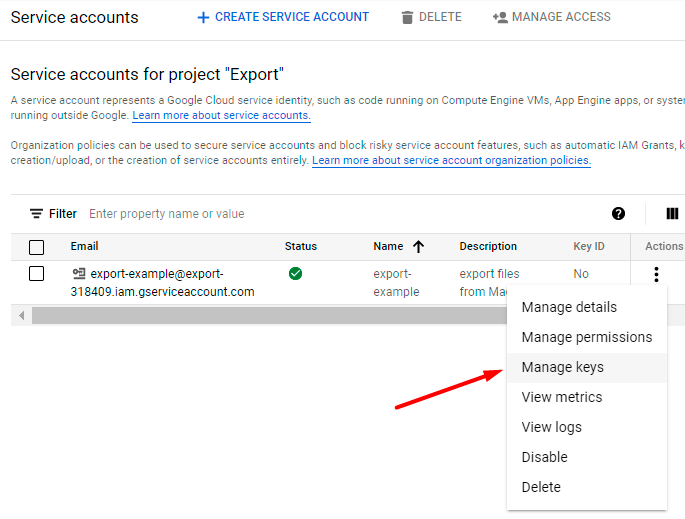
8. Expand the Add Key dropdown and select Create new key.
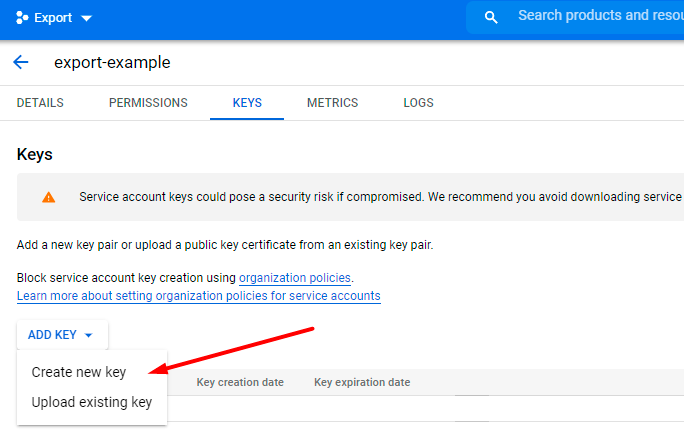
9. Choose JSON file format and hit the Create button.
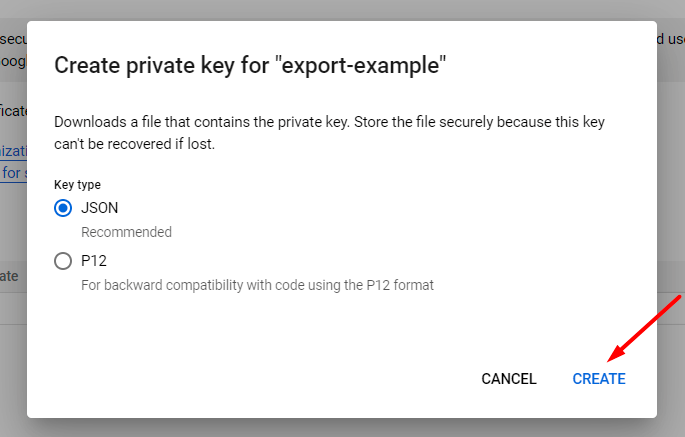
The file will be automatically generated and downloaded.
10. Proceed to the Details tab and copy the email.
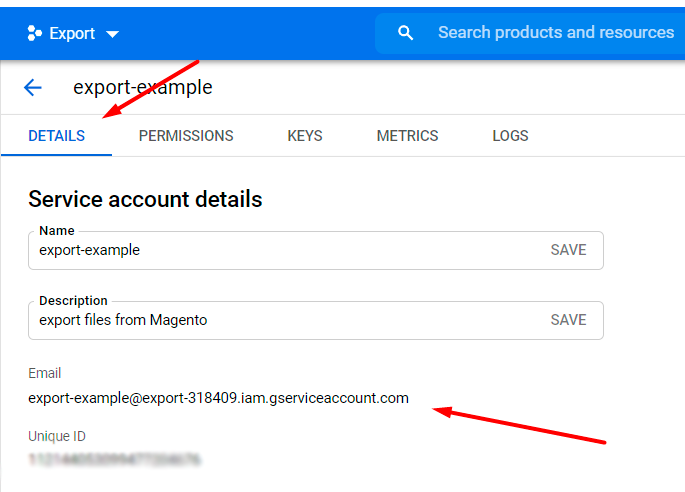
11. Go to My Drive. Create a folder to which export files will be output from Magento. Specify the title.
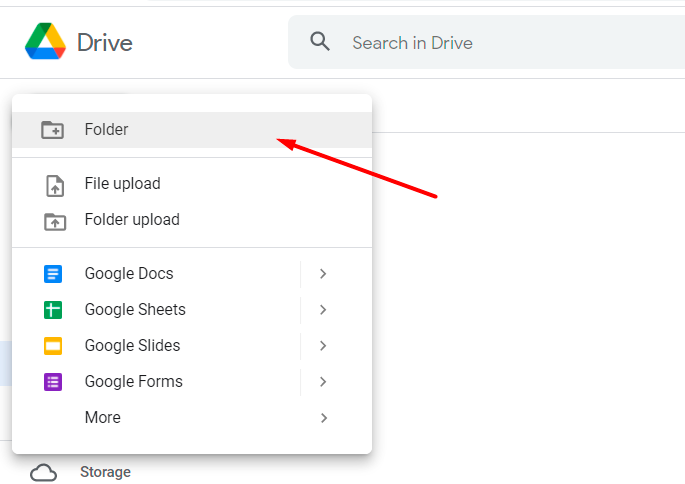
12. Now click Share and insert the email that you've copied. Click Done.

13. Return to the admin panel. Upload a JSON file, provide the path to the created folder and specify an export file naming with or without data format.
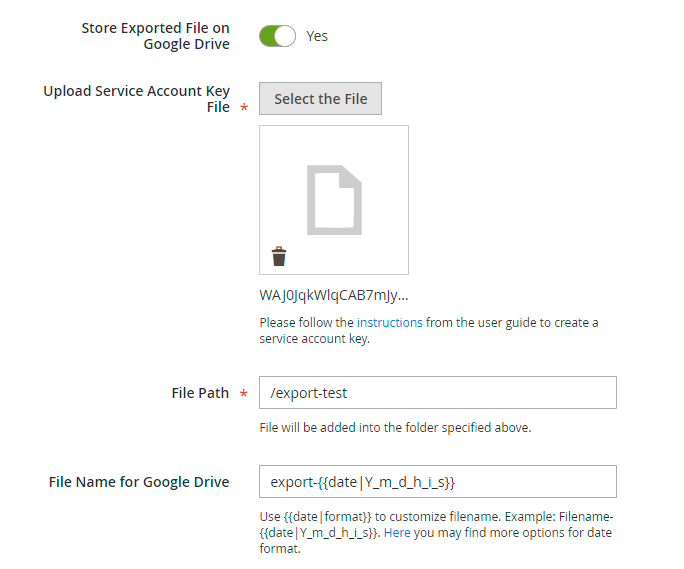
The configuration is ready. Run export profile and check the file in the Drive folder.
File Settings
On the following step, you need to choose the required file type and configure its general settings.

The following formats are available:
- CSV
- XML
- ODS
- XLSX
- JSON
- Template
For CSV, ODS and XLSX formats you can:
Add Header Row - column titles will be displayed in this row.
Export Field Names without Entity Keys – set to Yes to exclude entity keys (prefixes) from the header rows (column titles) in CSV, ODT, and XLSX export files.
Please note the feature is available as a part of an active product subscription or support subscription. You can find the amasty/module-export-subscription-functionality package for installing in composer suggest.
Merge Rows into One - data from multiple rows will be merged into one cell if enabled. The character that delimits each field of the child rows is customizable. Check the GIF in a demo to see how it works.
Duplicate Parent Entity Data - if enabled, the values of the child entities will be duplicated from the parent one.
See how it works
If disabled, child values are empty:

If enabled, the values are duplicated:

Please, use the setting while exporting one sequence of subentity, e.g. Order - Order Item - Product - Product Attribute, to avoid duplicating independent data.
For a CSV file you can additionally set:
- Field Delimiter
- Field Enclosure Character
For a XML file you can customize:
- XML Item Tag
- Header
- Footer
XSLT Editor
The extension includes an XSLT editor so that you could output XML files with any custom formatting. Using this functionality, you can create custom templates for XML documents and add, remove, rearrange or sort elements in the file.
What is XSLT?
A lot of 3rd-party platforms you are integrating with use custom XML table formatting. Magento itself can't adapt such files automatically since each platform has its own requirements. XSLT (Extensible Stylesheet Language Transformations) helps to interpret the values from the Magento database and put them in an XML document. The editor helps to organize data in the file and make it acceptable for the platform you are exporting to.
Find out how the XSLT works in this tutorial.
Before exporting a custom XML file, review the formatting requirements and find out how the attributes provided in the document are named and structured in Magento. Then, create an Xsl Template to match the values.
To simplify template creation, download this ready-made sample file:
xsl-template-for-export.zip
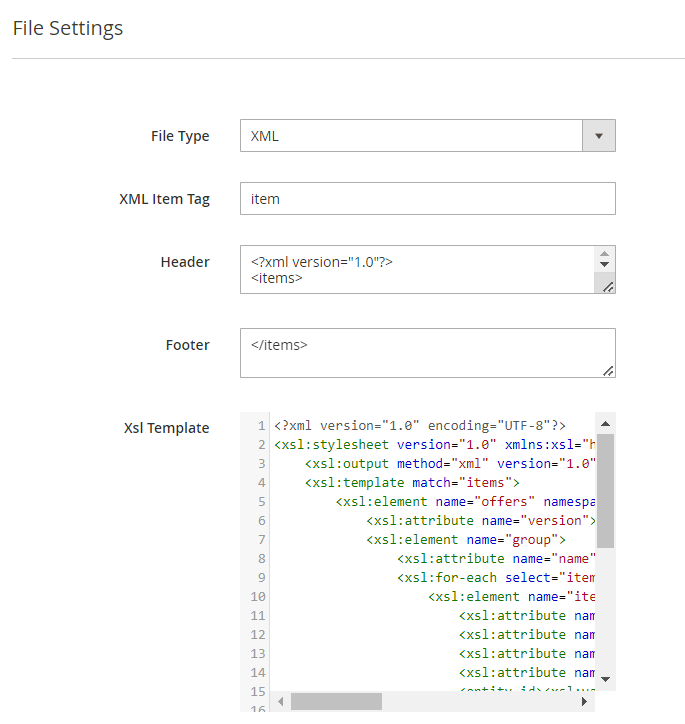
For JSON specify:
- Header
- Footer
For Template:
Using the Template option, you can build a unique file suitable for specific needs. Thanks to the integrated Twig PHP template engine, you can create any template you want to:

The extensions offers templates for .CSV and .JSON file types. To help you export subentities via .CSV using Twig template engine, please follow the steps below.
How to export subentities to CSV file using Twig
1. Enable the required subentity (‘Order Item’ for example) and add the fields you would like to export (‘sku’).

2. Determine the property name of each entity element in the chain. For example, for ‘Order Item’ subentity, the property name will be ‘sales_order_item’ of the root entity variable ‘item’ (item.sales_order_item).
The property name of the required entity can be found in the corresponding entity definition file. For example, for the subentity ‘Order Item’ it will be the file etc/entity/sales_order_item.xml (path is relative to ‘Amasty_OrderExportEntity’ extension files). The file can be found by the entity name contained in the name element, for example ‘<name>Order Item</name>’. Next, the required entity relation should be found in the file. In our case, ‘Order (root entity)’ → ‘Order Item’. Information about relations is contained in the elements ‘relation’ and the essence of relations is described in the attribute ‘code’. So we find the element ‘<relation code=“order_order_item”>’. The child element ‘sub_entity_field_name’ will contain the name of the property we are interested in (‘sales_order_item’).
3. Then use the loops to get information from subentities. To access the subentity ‘Order Item’ (‘sales_order_item’), use the following construction of the Twig template engine: {% for order_item in item.sales_order_item %}
As a result, the ‘sku’ property of the ‘order_item’ variable will contain the necessary information (‘order_item.sku’).
4. You can also use the filter ‘join (',')’ Twig to join an array of elements into a string.
{# Comment: You should enable Order Item subentity and add sku field. #}
{% set order_items = [] %}
{% for order_item in item.sales_order_item %}
{% set order_items = order_items|merge([order_item.sku]) %}
{% endfor %}
{% set order_items_ouput = order_items|join(',') %}
"{{
"#{ order_items_ouput }"
}}"
5. To access more nested entities, you need to use several loops. For example, to access the subentity ‘Shipment Item’, you need to go through the chain of entities ‘Order (root entity)’ → ‘Shipment’ → ‘Shipment Item’.

See Twig documentation to learn more about the features and configuration.
Fields Configuration
In this tab, you can start building your export file by choosing the data to export. The functionality has a tree structure. Thus, you can add any entity, any field within a particular entity, customize prefixes/tags/delimiters and so on to match the requirements of the system you are exporting to.
See how the tree-structures file is built:
Step 1. Add root entities
First, you need to configure the basic order entity and select the fields that will be added to the file on the root level.
Click Add Fields button and choose the relevant data to add to the export file.

Use a search window right in the popup to find the required fields faster. Click Add Selected Fields.
When a field is added, you can customize a column title that will be displayed in the exported file. Moreover, use the Add Static Filed button to create columns that will remain unchanged in the file.
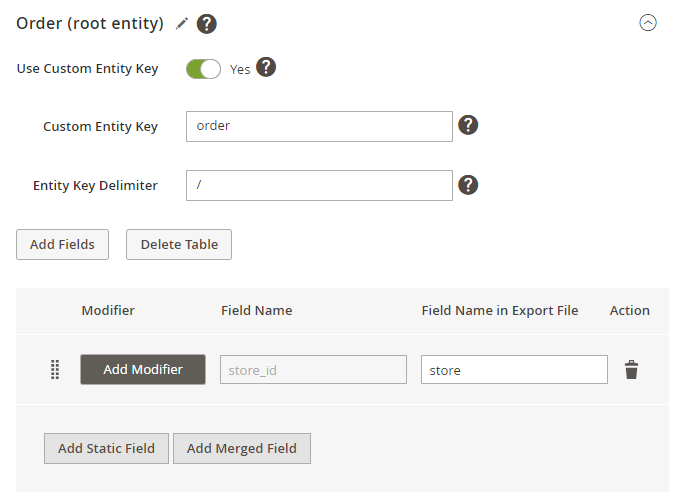
By clicking the Add Merged Field button, you can create custom columns that combine data from multiple fields. Also, it’s possible to customize the names of these columns and use symbols or words (such as 'and' or '/') to separate the data within them.
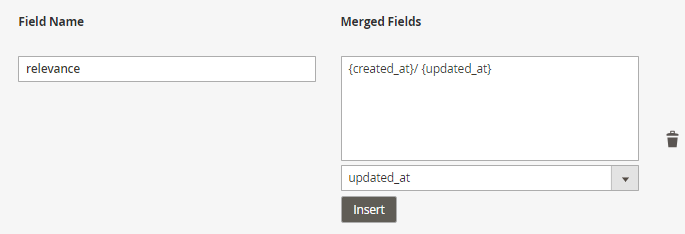

Please note that adding merged fields is available as a part of an active product subscription or support subscription.
Customize fields sorting within each entity using the drag-and-drop option.
Also, for each file level, you can set a custom entity key, delimiter and a field name. Check how it works:
Step 2. Add subentities
Then you can go down the entity list and enable any you need.
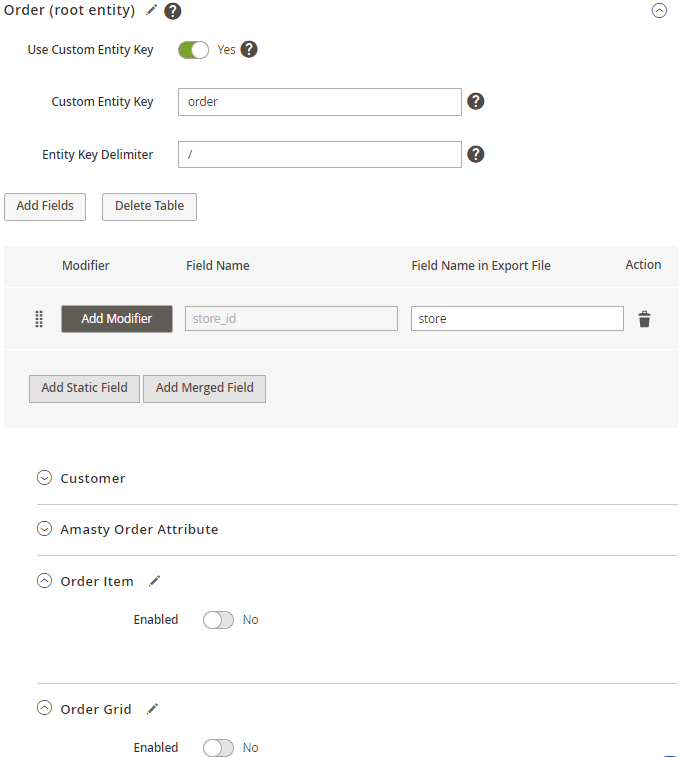
Just hit the Enabled toggle and Add Fileds button. As it was described above, a popup will appear and you will be able to add all required fields concerning a particular entity. For example, for the Order Item entity, you may add product type, sku, price, etc.
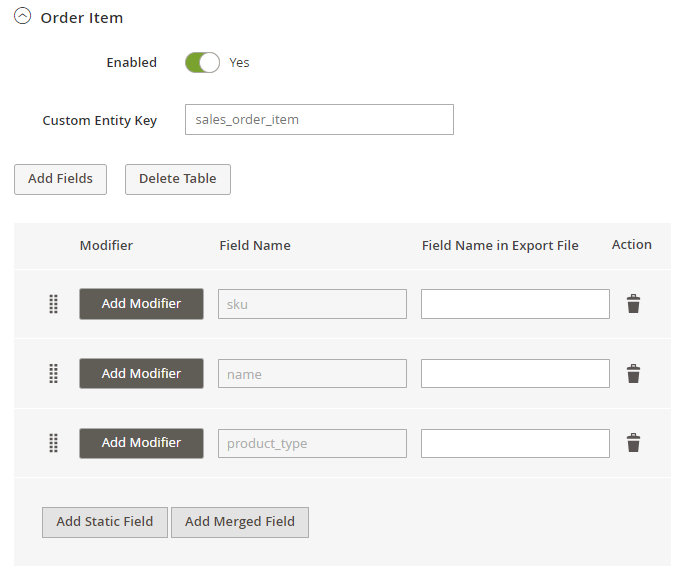
The same can be done for the entities with a lower level, such as Order Item Attribute or Order Item Custom Option.
The MSI Inventory Reservation subentity, nested within the Order Item entity, allows specifying the reserved product quantities in the export file, provided the fields of this subentity are properly mapped.
Also, the extension support MSI functionality. You can find the required fields on the Shipment level in the Inventory Source tab.
Thus, you can build a unique profile, suitable for a particular system. Check the requirements from a system (as, for example, ERP or B2B invoicing company needs different order data) and match the details.
Adding Product Attributes
To include particular product attributes into the export profile, navigate to Stores → Attributes → Product.
For example, we want to add a manufacture attribute. So, we open a particular attribute and proceed to the Order Export tab.

Choose Yes in the Add to Options field and Save the attribute.
After that, you need to run Reindex, as the attribute will become available in the export configuration profile only after the reindexation.
Check the result. You will see manufacture attribute in the Fields configuration tab of the export profile (Order Item → Order Item Attribute section).
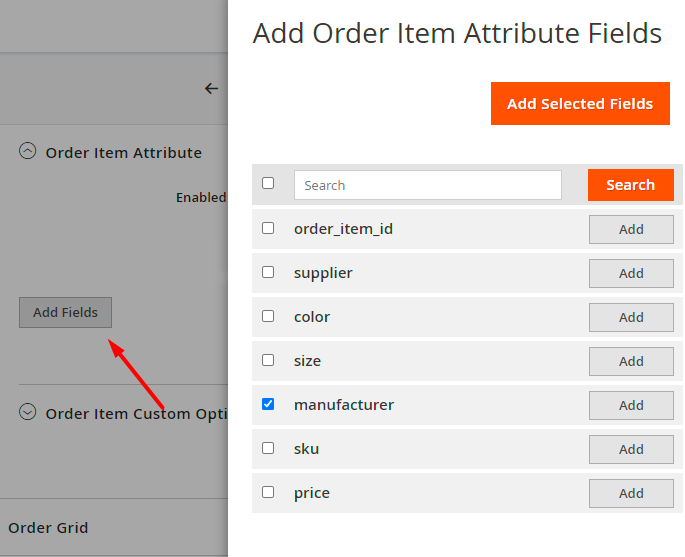
Also, now you can filter orders by the added product attribute.
Modify Values in Export Files
Now you can use modifiers to change the values in the export file. For example, you can change the date format, add any text and apply various mathematical actions to prices (e.g. rounding, multiplication, etc.).
Modifiers are added right during the fields configuration.
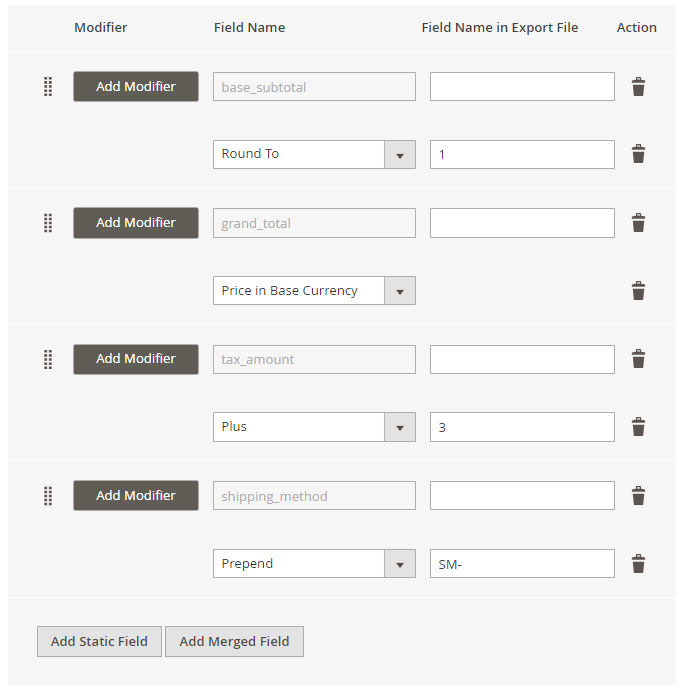
Hit the Add Modifier button and choose the required action in a dropdown.

Types of modifiers you can use:
- Text Modifiers: Adjust the text of the text values by appending, prepending, capitalizing, etc.
- Numeric Modifiers: Use for number modifications, e.g. rounding prices.
- Date Modifiers: Specify a suitable date format.
- Custom Modifiers: Replace the output of one field with the value of another.
Text Modifiers
Append - Adds the text after the value in the column. The text is specified in an additional field that appears when this modifier is selected.
Prepend - Adds text before the value in the column. The text is specified in an additional field that appears when this modifier is selected.
Capitalize - After selecting this modifier, the value in the column is capitalized.
Lower Case - After selecting this modifier, the whole word is written in lowercase.
Upper Case - After selecting this modifier, the entire word in a value field is capitalized.
Capitalize Each Word - After selecting this modifier, each word starts with a capital letter.
Strip Html Tags - Modifier removes all HTML tags from the string (the modifier is useful when exporting meta titles, descriptions, etc.).
Replace - After choosing this modifier, 2 fields appear: in the first one we indicate the word that needs to be replaced, and in the second one - the word to be replaced with.
Full Match Replace modifier functions similarly to the Replace modifier. However, it only replaces the value from the first field (From) with the value from the second field (To) when the value from the first field is fully matched.
For example, if you specifically need to replace only '2' with '3', it's better to choose the Full Match Replace modifier. This is because if you opt for the Replace modifier instead, specifying From: '2' and To: '3', it might result in '122' being replaced with '133' due to the presence of '2'.
Replace First - the same as Replace, but for the first case only.
Replace Text Wrapping - After selecting this modifier, the wrapping of multiline text is replaced with space by default. You can remove the space in the dependent field and enter another character you’d like to replace the wrapping of multiline text with.
Default value - When this modifier is selected, indicate the value that is added to the corresponding column by default (there is already a defaultValue).
Trim - This modifier removes spaces from the beginning and the end of the string (there is already a trim).
Numeric Modifiers
Price - Modifier adds currency to the value in the column.
Absolute Value - Modifier changes the negative value in the column to positive. Example: was -5 → now is 5.
Round To - When this modifier is selected, an additional field appears, in which we indicate the number of decimal places to which we round the number in the column. Example: 33.75 → enter 1 → get 33.8.
Plus - When this modifier is selected, indicate the number that is added to the number in the column.
Minus - Indicate the number that is subtracted from the number in the column.
Multiplied By - Specify the number that is multiplied by the number in the column.
Divided By - Provide the number by which the number in the column is divided.
Modulo - Indicate the number by which the number in the column is divided, and when division occurs, we get the remainder of the division in the export file. Example: we have 10, entered the number 3, received 1 in the file.
Truncate - Modifier removes decimal numbers without rounding. For example: 33.75 → Truncate → 33.
Ceil - Modifier allows you to round a number up to the nearest whole number.
Floor - Modifier allows you to round a number down to the nearest whole number.
Date Modifiers
Date Format - Specify the date format that is applied to the date in the file.
Apply Timezone - Choose the modifier for a timezone in UTC format.
Custom Modifiers
Сustom modifiers replace the output of the value of one field with the value of another. For example, Value to Label: instead of value, the label will be displayed. Or, for instance, set id to set name: instead of id, the name will be displayed.
Export Filters
In the next tab, you can define which orders should be exported using filtering. For example, you may add only configurable products to the export file. Filtering also has a tree structure and is on the same level as export fields.

Expand the necessary entity, click Add Filter and specify the value you need to export.

Also, you can use specific filters for the Date parameter, e.g. export orders placed in the last X days or weeks.
Filter After Modifier Applied - check this toggle to filter data only after apllying particular modifier. For example, you can modify the timezone and apply date filter to the 'created_at' field after the modification.
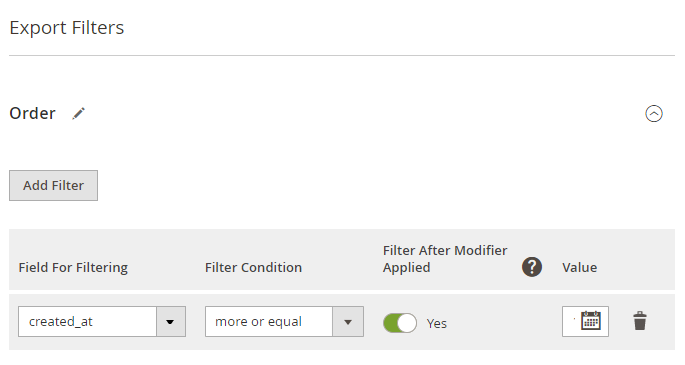
Please make sure the field with a corresponding modifier is added to the export file. Otherwise, the setting won't be applied.
Additionally, you can Exclude Parent Entity Row If No Results Found. It means that the parent entity row will be excluded from the export file if the child entity doesn't have filter results relative to the parent entity.
Check how it works:
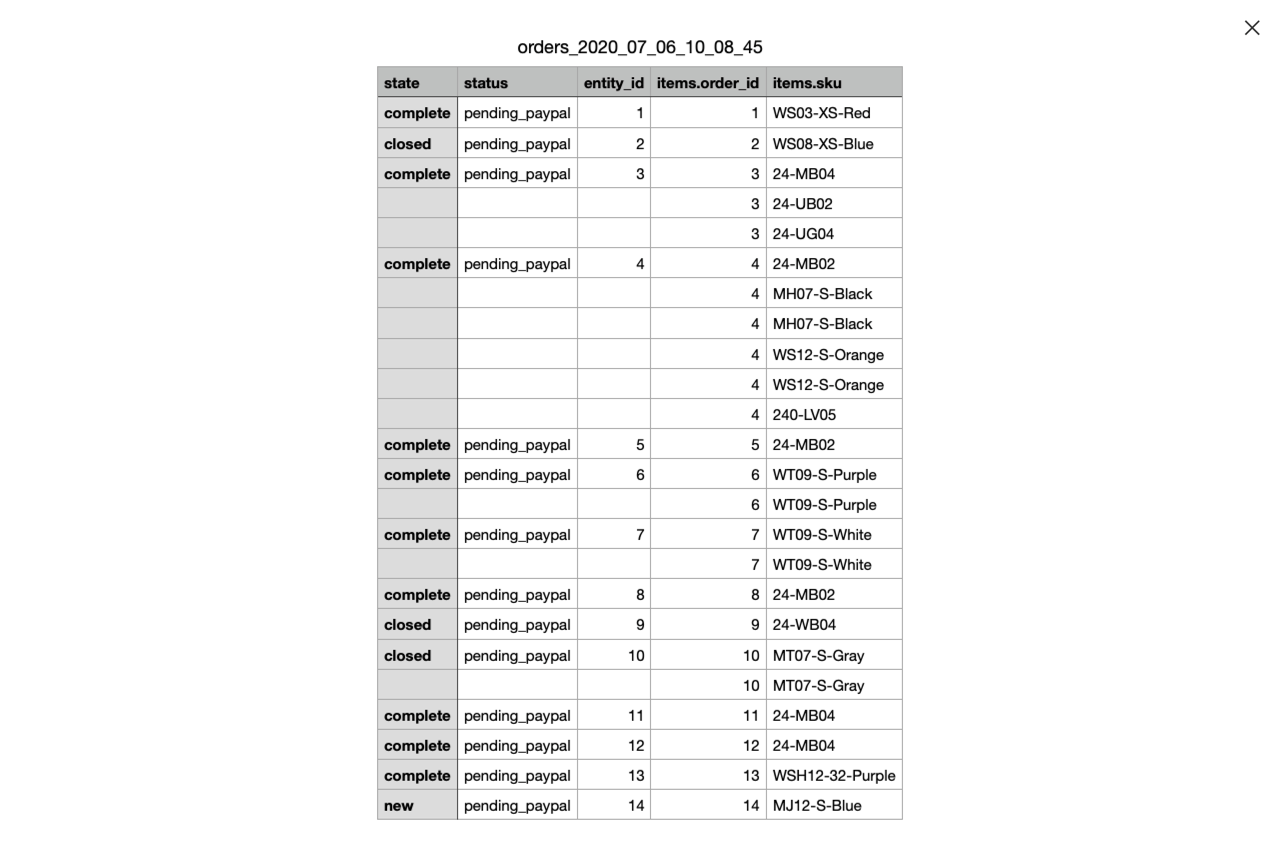
Automatic Export
Set the frequency to run the profile. 2 modes to run a profile are available:
- by Cron
- by event
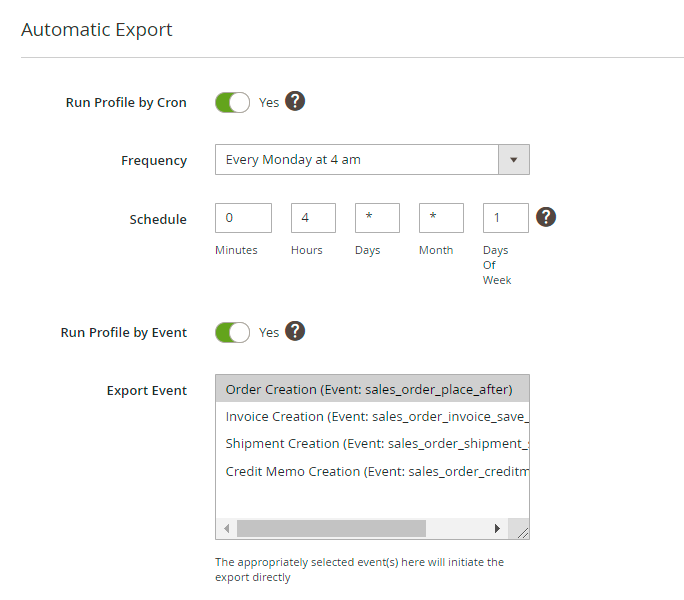
For exporting by cron, you need to set one of the ready-made schedules or create a custom one.
For exporting by event, choose the particular event that will trigger a profile export.
Alert Notifications
Using this tab, you can enable email notifications about errors for a particular profile.

Enable Email Alert - set to Yes to notify the recipients about failed exports.
Email Sender - choose the contact that will send automatic emails.
Email Recipients - set to whom the emails will be sent.
Email Template - select the template for failure notifications.
Profile Export History
For each profile a separate export history is available. Check the statuses, dates, logs and the exported number of orders. Download a file if necessary.
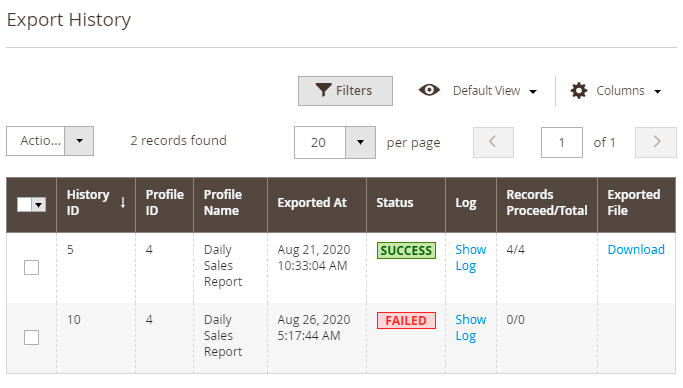
General Export History
You may also check the logs for all order exports (one-time, cron jobs, and profiles) in one place. Navigate to System → Amasty Export → Export History. See the statues and check the details to get a full picture.
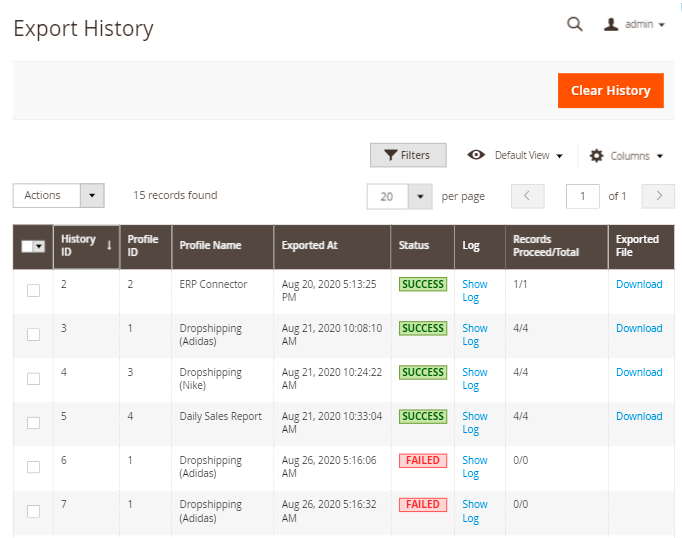
You can easily identify the export method in the Entity column:
- Manual - one-time exports;
- Cron – exports via cron job interface;
- Export Orders – profile exports.
REST API and CLI requests
It is possible to run import and export profiles using the REST API and CLI.
REST API:
- “/V1/am_import_export/get_profile_runners/” method=“GET” - to get available profile runners
- “/V1/am_import_export/run_profile/” method=“POST” - to run a profile
- “/V1/am_import_export/check_profile_status/” method=“POST”- to check profile status
CLI:
- php bin/magento am-import-export:show-profile-runners-list
- php bin/magento am-import-export:run-profile product_import_profile 1
- php bin/magento am-import-export:check-profile-status product_import_profile %identity_from_run_command%
3rd Party Links
With the extension, you can link the data generated by 3rd party extensions to the export functionality. All created connections are displayed in the System → Amasty Export → 3rd Party Connections tab.
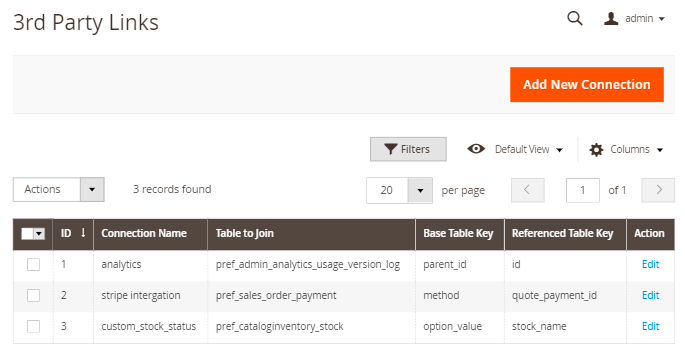
Hit the Add New Connection button to create a new link.

Name - specify the connection title for internal usage.
Export Type - select the Export Orders entity for 3-rd party connection.
Table to Join - indicate a table name that needs to be joined.
Parent Entity - choose the entity table to which the foreign table will be joined.
Referenced Table Key - the field from the foreign table, by which the table chosen in 'Table to join' will be joined to the parent entity table.
Base Table Key - specify the field from the parent entity table which will be used for joining with the foreign table.
Save the changes. Now you can add this entity to the export file.
Amasty Export: Fast & Easy
This extension is helpful to perform one-time operations as it has a simplified UI. If you have only Export Orders extension, you will be able to export any order entity, but if you have other export extensions by Amasty, you will easily export any available entity in one place.
Go to System → Amasty Export → Export and select the entity to export.
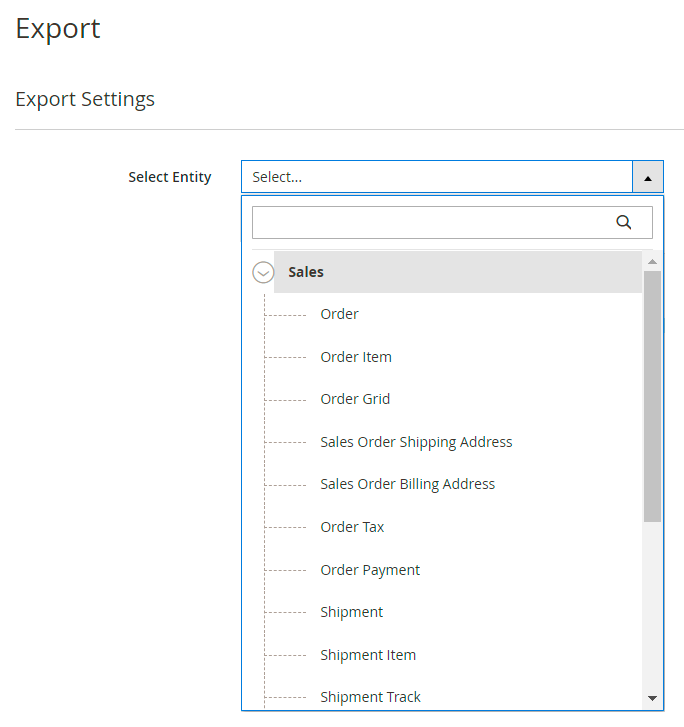
As soon as you choose the entity, you will be able to configure export details, such as format, title, included fields, etc. Check each configuration details for each tab in the Export Profile Configuration sections.
General Settings
To configure the basic options for Amasty Export, navigate to Stores → Configuration → Amasty Extensions → Export.

Enable Multi-Process Export - set to Yes to speed up the export.
The 'Multi-Process Export' feature requires the PHP extension 'pcntl' to be installed on the server. If you enable the feature and no performance boost happens, please ask your hoster/system administrator to check if the 'pcntl' extension is installed.
Number of Parallel Processes - specify the number of processes according to your server capabilities. The more parallel processes are set, the faster the export process goes, but the higher the server loads.

Enable Debug Mode - set to Yes to allow the system to detect errors and display detailed information about them in the popup (including server errors). Also, error information can be found in var/log/amasty_import_debug.log.
Process Status Check Mode - select the Statuses option if you are using a multi-node environment (this helps prevent possible errors). If you are not using a multi-node environment, please leave the System Process ID option selected.
Enable Export without Memory Limit - enable the setting if the export process terminates because the memory limit exceeds to allow using all available memory volume for the export process.
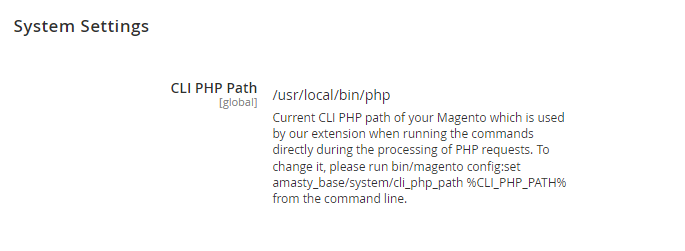
CLI PHP Path - using this option, you can check the Magento path which is used by our extension when running the commands directly during the processing of PHP requests. To change it, please run the following command:
bin/magento config:set amasty_base/system/cli_php_path %CLI_PHP_PATH%
If you run a command and a new path is not displayed in this setting, please recheck the path you've specified. In case the path is incorrect, the changes won't be applied to the admin panel and you'll see the default path.
Amasty Export Pro
Also, the extension includes Amasty Export Pro features: you can create regular cron jobs to export any available entity.
Go to System → Amasty Export → Cron Jobs.
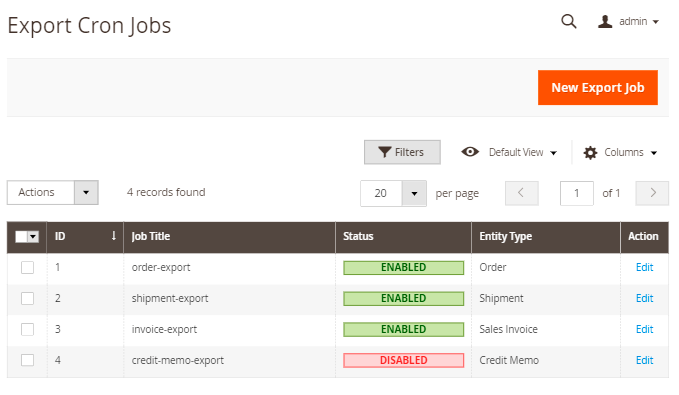
The more installed Amasty Export extensions you have, the more entities you can export by cron.
Click New Export Job.
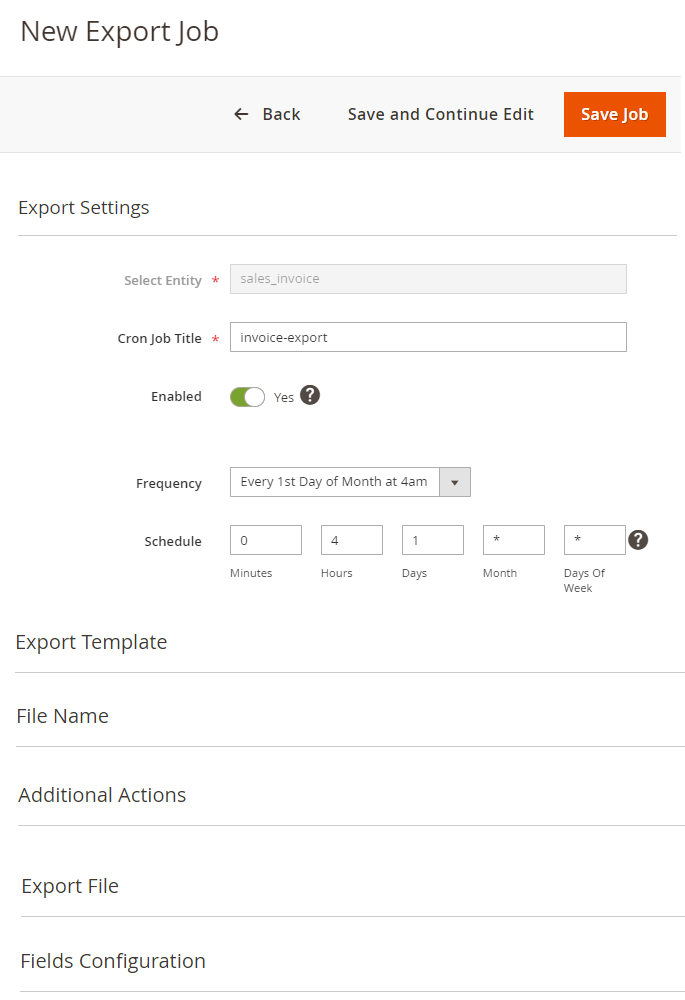
Specify the cron job title for internal use and set the schedule for exporting. The file configuration algorithm is the same as described in the Export Profile section.
Compatibilities
Export orders are compatible with Amasty Order Attributes extension. Thus, you can find and add custom order fields to the export file.
Also, the extension supports Amasty One Step Checkout so that you could add more order details from your checkout page to the export file.
Export Gift Card information if you have both modules installed.
The same can be done with RMA requests.
Additional packages (provided in composer suggestions)
To make additional functionality available, please install the suggested packages you may need.
Available as a part of an active product subscription or support subscription:
amasty/module-export-merged-fields- This package provides the possibility of merging several export field values into one field.
amasty/module-export-subscription-functionality- Install this package to exclude entity keys (prefixes) from the header rows (column titles) in CSV, ODT, and XLSX export files.
Find out how to install the Export Orders extension for Magento 2 via Composer.
magento_2/export_orders.txt · Last modified: 2025/07/17 08:11 by kkondrateva



